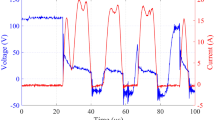Abstract
In electrical discharge machining (EDM), gap control is the key to stable processing; the discharge gap plays a significant role in EDM. To determine the influence of the discharge gap on material removal and melt pool movement, which are two fundamental issues in EDM, high-speed photography and molecular dynamics (MD) simulations were used to study the discharge process. Research results demonstrate that the discharge gap has a significant influence on material removal during the discharge process. A smaller gap width produces more and larger removed materials. The influence mechanism of the gap width on material removal is explained as follows. A smaller gap width produces discharge plasma with a smaller diameter and greater heat flux. Discharge with a greater heat flux generates more material removed during the discharge process. In addition, a smaller gap width and greater heat flux produce a stronger interaction of metal vapor jets, generating a stronger shear force acting on the melt pool. The discharge gap also influences the movement of the melt pool and the final topography of the discharge crater through external pressure acting on the melt pool. Smaller gap width produces greater external pressure acting on the melt pool, generating a bowl-shaped melt pool and a discharge crater with a depression in the center and a bulge around the edge. A larger gap width produces less external pressure acting on the melt pool, generating a flat melt pool and a discharge crater with swelling in the center and a depression around the edge.












source diameter of 16 nm

source diameter of 20 nm

source diameter of a 16 nm and b 20 nm, respectively










Similar content being viewed by others
References
Zhang M, Zhang Q, Dou LY, Zhu G, Dong CJ (2016) An independent discharge status detection method and its application in EAM milling. Int J Adv Manuf Technol 87:909–918. https://doi.org/10.1007/s00170-016-8537-0
Kunieda M, Miyoshi Y, Takaya T, Nakajima N, Yu ZB, Yoshida M (2003) High speed 3D milling by dry EDM. Cirp Ann-Manuf Techn 52(1):147–150. https://doi.org/10.1016/S0007-8506(07)60552-6
Kunieda M (2013) Electrical discharge machining processes. In: Andrew YCN (ed) Handbook of manufacturing engineering and technology. Springer, London, pp 1–26
Zhou M, Mu X, He L, Ye Q (2019) Improving EDM performance by adapting gap servo-voltage to machining state. J Manuf Process 37:101–113. https://doi.org/10.1016/j.jmapro.2018.11.013
Nakagawa T, Yuzawa T, Sampei M, Hirata A (2017) Improvement in machining speed with working gap control in EDM milling. Precis Eng 47:303–310. https://doi.org/10.1016/j.precisioneng.2016.09.004
Rajurkar KP, Wang WM, Lindsay RP (1989) A new model reference adaptive control of EDM. Cirp Ann-Manuf Techn 38(1):183–186. https://doi.org/10.1016/S0007-8506(07)62680-8
Rajurkar KP, Wang WM, Lindsay RP (1990) Real-time stochastic model and control of EDM. Cirp Ann-Manuf Techn 39(1):187–190. https://doi.org/10.1016/S0007-8506(07)61032-4
Tee KTP, Hoseinnezhad R, Brandt M, Mo J (2013) Gap width control in electrical discharge machining, using type-2 fuzzy controllers. International Conference on Control, Automation and Information Sciences (ICCAIS) 140–145. https://doi.org/10.1109/ICCAIS.2013.6720544
Xin B, Gao M, Li SJ, Feng B (2020) Modeling of interelectrode gap in electric discharge machining and minimum variance self-tuning control of interelectrode gap. Math Probl Eng 2020:1–20. https://doi.org/10.1155/2020/5652197
Kunieda M, Takaya T, Nakano S (2004) Improvement of dry EDM characteristics using piezoelectric actuator. Cirp Ann-Manuf Techn 53(1):183–186. https://doi.org/10.1016/S0007-8506(07)60674-X
Philip JT, Mathew J, Kuriachen B (2021) Transition from EDM to PMEDM – Impact of suspended particulates in the dielectric on Ti6Al4V and other distinct material surfaces: a review. J Manuf Process 64(2):1105–1142. https://doi.org/10.1016/j.jmapro.2021.01.056
Li ZK, Bai JC (2017) Impulse discharge method to investigate the influence of gap width on discharge characteristics in micro-EDM. Int J Adv Manuf Tech 90:1769–1777. https://doi.org/10.1007/s00170-016-9508-1
Takeuchi H, Kunieda M (2007) Relation between debris concentration and discharge gap width in EDM process. Journal of The Japan Society of Electrical Machining Engineers 41(98):156–162. https://doi.org/10.2526/jseme.41.156
Morimoto K, Kunieda M (2009) Sinking EDM simulation by determining discharge locations based on discharge delay time. Cirp Ann-Manuf Techn 58(1):221–224. https://doi.org/10.1016/j.cirp.2009.03.069
Hayakawa S, Takahashi M, Itoigawa F, Nakamura T (2004) Study on EDM phenomena with in-process measurement of gap distance. J Mater Process Tech 149(1–3):250–255. https://doi.org/10.1016/j.jmatprotec.2003.11.057
Yue XM, Yang XD, Kunieda M (2018) Influence of metal vapor jets from tool electrode on material removal of workpiece in EDM. Precis Eng 53:278–288. https://doi.org/10.1016/j.precisioneng.2018.04.012
Yue XM, Yang XD, Li Q, Li XH (2020) Novel methods for high-speed observation of material removal and melt pool movement in EDM. Precis Eng 66:295–305. https://doi.org/10.1016/j.precisioneng.2020.07.009
Sandia Corporation (2017) LAMMPS. http://lammps.sandia.gov/. accessed 13 November 2017
Foiles SM, Baskes MI, Daw MS (1986) Embedded-atom-method functions for the fcc metals Cu, Ag, Au, Ni, Pd, Pt, and Their Alloys. Phys Rev B 33:7983–7991. https://doi.org/10.1103/physrevb.33.7983
Erkoc S (1997) Empirical many-body potential energy functions used in computer simulations of condensed matter properties. Phys Rep 278(2):79–105. https://doi.org/10.1016/S0370-1573(96)00031-2
Xia H, Kunieda M, Nishiwaki N (1996) Removal amount difference between anode and cathode in EDM process. International Journal of Electrical Machining 1:45–52. https://doi.org/10.2526/jseme.28.59_31
Yue XM, Yang XD (2017) Molecular dynamics simulation of single pulse discharge process: clarifying the function of pressure generated inside the melting area in EDM. Mol Simulat 43(12):935–944. https://doi.org/10.1080/08927022.2017.1306649
Funding
This work was financially supported by the National Science Foundation of China (Nos. 51805164, 51875133) and China Postdoctoral Science Foundation (2020M672052).
Author information
Authors and Affiliations
Contributions
Xiaoming Yue: Conceptualization, Methodology, Investigation, Original draft preparation. Ji Fan: Data curation. Qi Li: Validation. Xiaodong Yang: Supervision, Writing-Reviewing and Editing, Funding acquisition. Zuoke Xu, Zhiyuan Chen: Software.
Corresponding author
Ethics declarations
Ethics approval
Not applicable.
Consent to participate
Not applicable.
Consent for publication
Not applicable.
Conflict of interest
The authors declare no competing interests.
Additional information
Publisher's Note
Springer Nature remains neutral with regard to jurisdictional claims in published maps and institutional affiliations.
Rights and permissions
About this article
Cite this article
Yue, X., Fan, J., Li, Q. et al. Influence of discharge gap on material removal and melt pool movement in EDM discharge process. Int J Adv Manuf Technol 119, 7827–7842 (2022). https://doi.org/10.1007/s00170-021-08577-z
Received:
Accepted:
Published:
Issue Date:
DOI: https://doi.org/10.1007/s00170-021-08577-z




